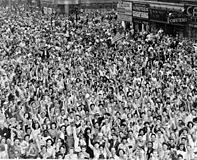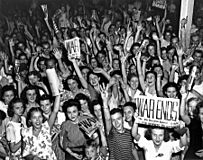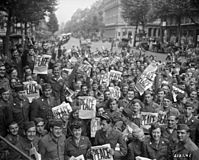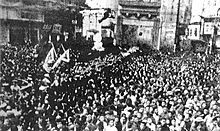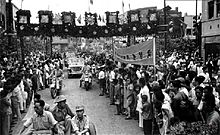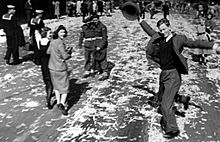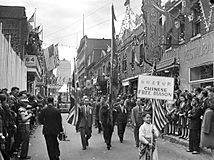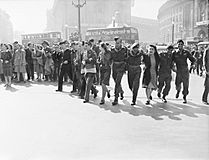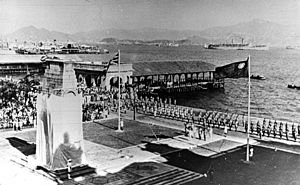Victory over Japan Day facts for kids
Quick facts for kids Victory over Japan Day |
|
|---|---|
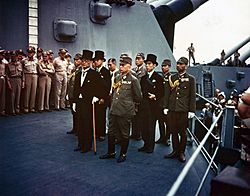
Representatives of the Empire of Japan aboard USS Missouri at the surrender of Japan on 2 September 1945
|
|
| Also called | V-J Day, Victory in the Pacific Day, V-P Day |
| Date | 2 September 1945 |
| Frequency | Annually |
| Related to | Victory in Europe Day |
Victory over Japan Day, often called V-J Day, is the special day when Imperial Japan officially gave up in World War II. This surrender effectively brought the huge war to an end. People use this name for two different dates. One date is August 15, 1945, when Japan first announced its surrender. Because of time differences, this was August 14, 1945, in places like the United States. The other date is September 2, 1945, when the official surrender document was signed. This signing truly marked the end of World War II.
The United Kingdom celebrates V-J Day on August 15. However, the United States officially remembers it on September 2. The Allies chose the name V-J Day after they had already named V-E Day for their victory in Europe.
On September 2, 1945, the formal surrender ceremony happened. It took place on the battleship USS Missouri in Tokyo Bay. In Japan, August 15 is usually known as the "memorial day for the end of the war" (終戦記念日, Shūsen-kinenbi). The official name for this day in Japan is "the day for mourning of war dead and praying for peace" (戦没者を追悼し平和を祈念する日, Senbotsusha o tsuitōshi heiwa o kinensuru hi). The Japanese government adopted this official name in 1982.
Contents
How the War Ended
Key Events Before Japan's Surrender
In August 1945, major events led to Japan's surrender. On August 6, the Allies dropped an atomic bomb on Hiroshima. Three days later, on August 9, another atomic bomb was dropped on Nagasaki. Also on August 9, the Soviet Union declared war on Japan. They then invaded Japanese-held areas.
On August 10, the Japanese government told the Allies they planned to surrender. They agreed to the terms of the Potsdam Declaration. This news sparked celebrations around the world.
Celebrations Around the World
When people heard Japan might surrender, early celebrations began. In London, Allied soldiers danced in the streets. Americans and French people in Paris marched and sang. American soldiers in West Berlin were excited. They hoped they would not have to go fight in the Pacific.
Germans thought the Japanese were smart to give up. They were also glad the atomic bomb was not used against them. In Moscow, newspapers briefly mentioned the atomic bombings. But the Soviet government did not comment on their meaning.
In Chongqing, China, people set off firecrackers. They showed great thanks to Americans. In Manila, people sang "God Bless America". On Okinawa, some American soldiers fired their weapons into the sky to celebrate. Sadly, six men died and many were hurt. Ships even sounded alarms and fired anti-aircraft guns. Their crews thought a kamikaze attack was happening. On Tinian island, B-29 crews were told their next mission was canceled. But they could not celebrate yet, in case the mission was rescheduled.
Japan Accepts the Potsdam Declaration
Just after noon on August 15, 1945, Emperor Hirohito spoke to the Japanese people on the radio. This was called the Jewel Voice Broadcast. He announced that Japan accepted the terms of the Potsdam Declaration. Earlier that day, the Japanese government had told the Allies they would surrender. They sent a message to U.S. President Harry S. Truman through Switzerland.
President Truman then made a nationwide radio announcement on August 14. He told everyone about Japan's communication. He also said the formal signing would be on September 2. Truman stated that "the proclamation of V-J Day must wait upon the formal signing of the surrender terms by Japan".
The European Axis Powers had surrendered three months earlier on V-E Day. So, V-J Day was the real end of World War II. A peace treaty between Japan and most Allies was signed in 1952. A treaty with the Soviet Union followed in 1956. In Australia, the day was called V-P Day (Victory in the Pacific) from the start. The Canberra Times mentioned V-P Day celebrations on August 14, 1945. The Australian government also made V-P Day a public holiday that year.
Public Celebrations Around the World
When news of Japan's acceptance spread, people started celebrating. Life magazine reported that joy seemed to explode. It was like happiness had been saved up since the attack on Pearl Harbor in 1941. In Washington, D.C., a crowd tried to get into the White House. They shouted, "We want Harry!"
The biggest crowd ever gathered in New York City's Times Square. The victory was announced on a news ticker at One Times Square. It read: "OFFICIAL * TRUMAN ANNOUNCES JAPANESE SURRENDER *". The asterisks stood for the branches of the U.S. Armed Forces. In the Garment District, workers threw fabric scraps and ticker tape. This left a five-inch-deep pile on the streets. The news of the war's end caused a "coast-to-coast frenzy of [servicemen] kissing . . . everyone in skirts". Life magazine published photos of these kisses from many cities.
-
Crowds celebrating V-J Day in Times Square on August 14, 1945
-
Citizens and workers of Oak Ridge, Tennessee celebrate V-J Day on August 14, 1945
-
Allied military personnel in Paris celebrating V-J Day on August 15, 1945
-
Crowds in Shanghai celebrating V-J Day on August 15, 1945
-
Chinese victory parade in Chungking on September 3, 1945
-
Dancing Man in Sydney on August 15, 1945
-
Montreal's Chinese community celebrates V-J Day with a parade in Chinatown on September 2, 1945
-
Civilians and service personnel in London celebrating V-J Day on August 15, 1945
Famous Photographs of V-J Day
One of the most famous photos from that day is V-J Day in Times Square. It was published in Life magazine. The photo was taken on August 14, 1945, after President Truman's announcement. People were gathering to celebrate. Photographer Alfred Eisenstaedt saw a sailor grab a woman in white and kiss her. He quickly took four pictures. Navy photographer Victor Jorgensen captured the same moment. His photo was published in the New York Times. Many people have claimed to be the sailor or the woman. It was later confirmed that the woman was Greta Zimmer Friedman, a dental assistant. She said in an interview, "it wasn't my choice to be kissed. The guy just came over and kissed or grabbed."
Another well-known photo shows the Dancing Man in Elizabeth Street, Sydney. A press photographer and a Movietone newsreel captured him. This film and the still photos became famous in Australia. They symbolize the victory in the war.
Japanese Reaction and POWs
On August 15 and 16, over 100 American prisoners of war (POWs) died. Many Australian and British POWs also died in Borneo. This happened at Ranau and Sandakan. At Batu Lintang camp in Borneo, orders were found to kill about 2,000 POWs and civilians. Luckily, the camp was freed four days before these orders could be carried out. Japanese forces also continued fighting Soviet forces for two weeks after V-J Day.
Official Ceremony on USS Missouri
The official signing of the Japanese Instrument of Surrender happened on September 2, 1945. It took place on the battleship USS Missouri in Tokyo Bay. On that day, President Truman declared September 2 to be the official V-J Day.
Timeline of Japan's Surrender
- April 1 – June 21, 1945: The Battle of Okinawa takes place. Over 82,000 U.S. military members were hurt or killed. More than 117,000 Japanese and Okinawans also died. About a quarter of Okinawa's civilians died.
- July 26: The Potsdam Declaration is issued. Truman warns Japan to surrender or face "prompt and utter destruction."
- July 29: Japan rejects the Potsdam Declaration.
- August 2: The Potsdam Conference ends.
- August 6: The U.S. drops an atomic bomb, called Little Boy, on Hiroshima. Truman warns Japan to surrender or "expect a rain of ruin from the air."
- August 9: The Soviet Union declares war on Japan. They invade several Japanese-held areas. The U.S. drops another atomic bomb, Fat Man, on Nagasaki.
- August 10: Japan tells the Allies it intends to surrender. They ask if the Emperor can remain in place.
- August 11: The Allies agree to Japan's surrender terms.
- August 14: Allied governments announce Japan's surrender. The Emperor tells his people in a radio broadcast. Newspapers call it "V-J Day" or "V-P Day."
- September 2: The official surrender ceremony is held on USS Missouri in Tokyo Bay. President Truman declares September 2 as the official "V-J Day."
- November 1: This was the planned start of Operation Olympic, the Allied invasion of Kyūshū.
- March 1, 1946: This was the planned start of Operation Coronet, the Allied invasion of Honshū.
- September 8, 1951: 48 countries, including Japan and most Allies, sign the Treaty of San Francisco.
- April 28, 1952: The Treaty of San Francisco begins. This formally ends the state of war between Japan and most Allied countries.
After the War:
- Some Japanese soldiers continued to fight on isolated Pacific islands. The last known Japanese soldier surrendered in 1974.
How V-J Day is Remembered
Australia's Commemoration
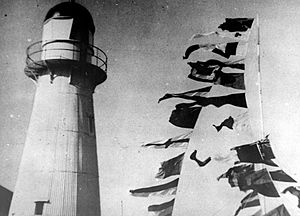
In Australia, many people prefer the term "VP Day" over "VJ Day." However, a 1946 publication called The Sixth Year of War in Pictures uses "VJ Day." Also, an Australian Government medal from 1995 has "VJ-Day" stamped on it.
Amateur Radio Remembrance
Amateur radio operators in Australia hold a "Remembrance Day Contest." It happens on the weekend closest to VP Day, August 15. This contest remembers amateur radio operators who died in World War II. It also helps improve participants' operating skills. The contest lasts 24 hours. It starts with a broadcast, including a speech by a leader. The names of amateur radio operators who died are also read. The Wireless Institute of Australia organizes this event. Operators in each Australian state contact operators in other states, New Zealand, and Papua New Guinea. A trophy is given to the state with the most participation.
China's Commemoration
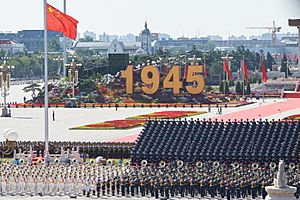
The final official surrender of Japan happened on the battleship USS Missouri on September 2, 1945. The Nationalist Government of the Republic of China was present. They announced three-day holidays to celebrate V-J Day, starting September 3. From 1946, September 3 was called "Victory of War of Resistance against Japan Day." This later became Armed Forces Day in 1955. September 3 is recognized as V-J Day in mainland China.
Hong Kong's Liberation Day
Hong Kong was returned by the Imperial Japanese Army to the Royal Navy on August 30, 1945. It went back to being a British dependency. Hong Kong celebrated "Liberation Day" on August 30 every year. This was a public holiday before 1997. After the transfer of sovereignty in 1997, the celebration moved to the third Monday in August. It was renamed "Sino-Japanese War Victory Day." This day was removed from the list of public holidays in 1999. In 2014, a ceremony was announced for September 3. This aligns with mainland China's "Victory Day of the Chinese people's war of resistance against Japanese aggression."
Korea's Liberation Day
Gwangbokjeol means "the day the light returned." It is celebrated every year on August 15. This is a public holiday in South Korea. It remembers Victory over Japan Day, which freed Korea from Japanese rule. This day is also a public holiday in North Korea. It is the only public holiday celebrated in both Koreas.
Mongolia's Dual Celebration
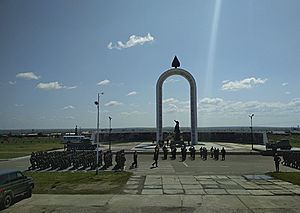
Victory over Japan Day is celebrated in two ways in Mongolia. It also celebrates the victory of Soviet and Mongolian forces in the Battles of Khalkhin Gol. The battle's anniversary was first celebrated in 1969. It was a big celebration every 5 years until 1989. After that, it became less important. Recently, the anniversary has become more significant again. The Mongolian Armed Forces celebrate it with the Russian Armed Forces. The President of Russia has joined the celebrations in Mongolia's capital for the 70th, 75th, and 80th anniversaries.
Netherlands' Remembrance
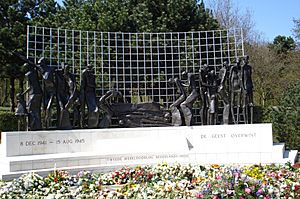
The Netherlands has one national and several local remembrance services. These happen on or around August 15. The national service is at the "Indisch monument" (Indies Monument) in The Hague. It remembers the victims of the Japanese occupation of the Dutch East Indies. The head of state and government usually attend. There are about 20 services in total, including at the Indies remembrance center in Bronbeek in Arnhem. The Japanese occupation marked the end of Dutch rule over Indonesia. Indonesia declared itself independent on August 17, 1945. This was just two days after the Japanese surrendered. The Indonesian War of Independence lasted until 1949. The Netherlands recognized Indonesian independence in December 1949.
Vietnam's V-J Day
On the day Japan surrendered, Hồ Chí Minh declared an independent Democratic Republic of Vietnam. Vietnam celebrates August 19 as V-J Day. This is because of the victory of the August Revolution against Japanese forces.
Philippines' Commemoration
In the Philippines, V-J Day is celebrated every year on September 3. It is called the "Surrender of General Tomoyuki Yamashita Day." The province of Ifugao observes September 2 as "Victory Day." This day remembers the bravery of Philippine war veterans. It also marks General Yamashita's informal surrender to Filipino-American troops in Kiangan on September 2, 1945.
Russia and Former USSR
Victory over Japan Day was made a holiday in the Soviet Union on September 3, 1945. The only celebration then was a parade of the Red Army in Harbin. In 1945 and 1946, it was a national holiday. Later, it became a working day with no celebrations. In modern Russia, Victory over Japan Day is a memorable date. It is celebrated as one of many Days of Military Honour. Some lawmakers have recently suggested making it a national holiday again.
A military parade of the Eastern Military District is held every year. It takes place in Yuzhno-Sakhalinsk or Khabarovsk. This is one of the few parades held on this day. Parades have also been held on September 2 in Russian areas that celebrate the anniversary of the Battles of Khalkhin Gol. These include Buryatia, Yakutia, and the Altai Republic. In Transnistria, Victory over Japan Day is celebrated with their Republic Day on the same day.
United States' Observance
September 2 is the official "V-J Day" in the United States. However, it is not an official federal or state holiday. Rhode Island celebrates the end of WWII as "Victory Day." It is observed on the second Monday of August.
V-J Day was first celebrated across the U.S. every year on September 2, starting in 1948. But as the war became a distant memory, the holiday faded. According to WPRI-TV, V-J Day was stopped for economic reasons. Workers got a paid day off. There was even a debate about whether Rhode Island would stop its Victory Day celebrations. Some towns still celebrate V-J Day. Moosup, Connecticut has an annual V-J Day parade. It happens on the second Sunday in August. It is the oldest continuous parade celebrating V-J Day since 1945. Arkansas was the only other state to make it an official holiday. But they stopped it in 1975. This leaves Rhode Island as the only state still celebrating.
World Peace Day
In the 1960s, some suggested making September 2 an international holiday. It would be called World Peace Day. This day would mark the anniversary of World War II's end. However, when this holiday began in 1981, it was set for September 21. This is the day the United Nations General Assembly starts its meetings each year.
See also
 In Spanish: Día de la Victoria sobre Japón para niños
In Spanish: Día de la Victoria sobre Japón para niños



